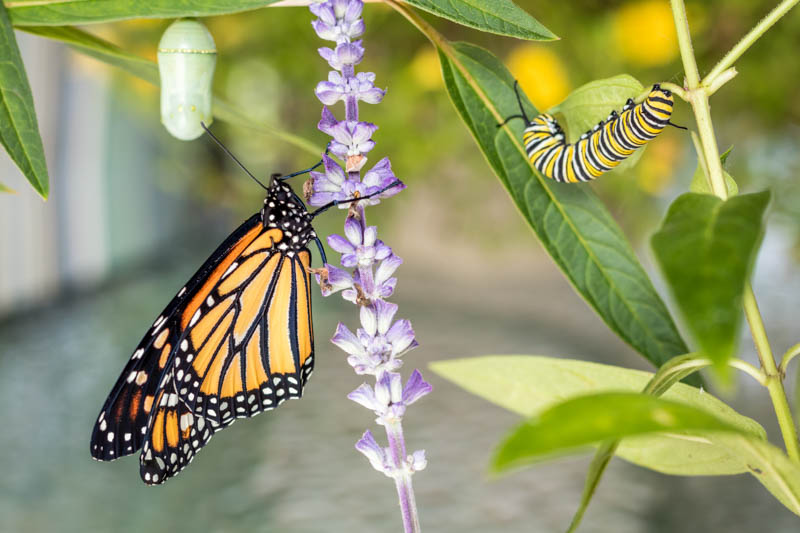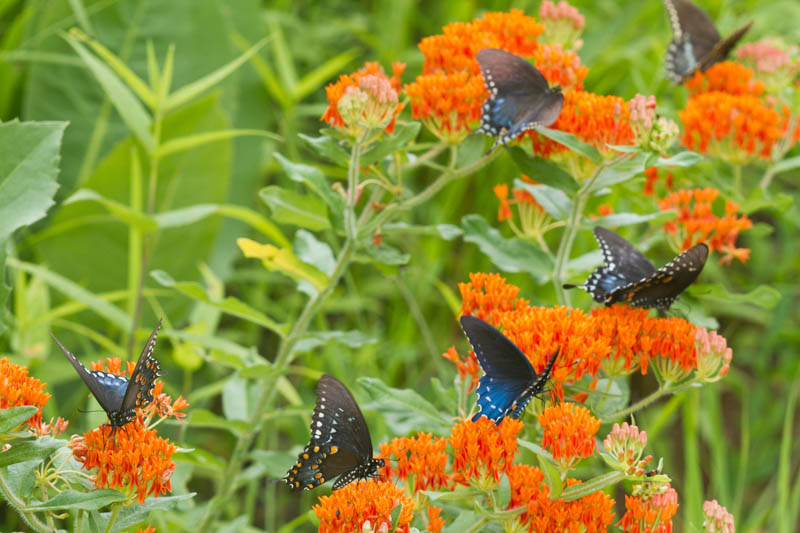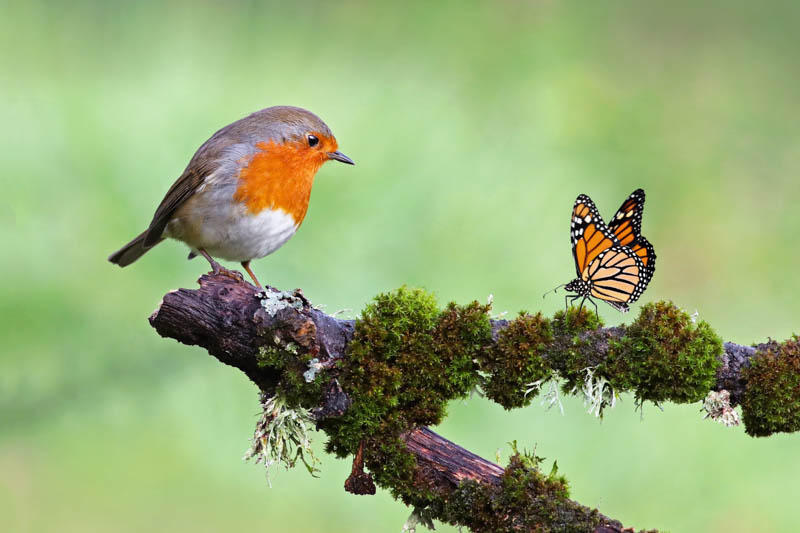Creating an enchanting butterfly garden is a rewarding venture that enhances the beauty of your outdoor space while supporting local ecosystems.
Key to Success: Understanding 5 Butterfly Basic Needs
To thrive,
butterflies need specific plants for their larvae (host plants), various nectar-rich flowers for adults, sunny areas for warmth and activity, shelter from harsh weather and predators, and a water source for hydration and minerals. These elements create a supportive habitat for their entire lifecycle.
1) Host Plants: Essential for Caterpillars to Feed On
The right host plants are crucial for butterfly larvae (caterpillars) to feed on and grow. Each butterfly species has specific plants that their caterpillars will eat. Here are some examples:
Planting Tips: Incorporate these plants into your garden in areas where the caterpillars can feed safely, away from high traffic.
 Monarch Trinity: Chrysalis, caterpillar and butterfly on milkweed
Monarch Trinity: Chrysalis, caterpillar and butterfly on milkweed
2) Nectar Plants: Provide Food for Adult Butterflies
Adult butterflies feed on nectar, so a variety of nectar-rich flowers are essential to attract and nourish them.
When selecting nectar plants for butterflies, diversity is key. Aim for a variety of species that bloom at different times, ensuring a steady supply of nectar throughout the growing season. Consider the following points:
Variety in Color and Shape:
Butterflies are attracted to a range of colors, with many favoring bright hues like purple, yellow, red, and pink. Include plants with different flower shapes and structures to cater to various butterfly species, as some prefer flat, open blooms while others like tubular flowers.
Some good options include
butterfly bush,
zinnia,
marigold,
black-eyed Susan,
sage,
coreopsis,
goldenrod, or
cosmos.
Native Plants:
Native plants are often the best choice for local butterflies, as they have co-evolved with them. These plants are usually well-adapted to the local climate and soil, requiring less maintenance.
Find native plants for your region or
discover our regional pollinator guides.
Continuous Blooming:
Choose plants that
bloom at different times – spring, summer, and fall – to provide nectar throughout the season. For example, lilac and lungwort for spring, coneflower, marigold, or hyssop for summer, and sedum, aster, goldenrod, or ironweed for late summer to fall.
Grouping Plants:
Plant nectar flowers in clusters rather than singly or widely spaced. This makes them more visible and attractive to butterflies.
 Pipevine Swallowtails (Battus philenor) on Butterfly Milkweed (Asclepias tuberosa)
Pipevine Swallowtails (Battus philenor) on Butterfly Milkweed (Asclepias tuberosa)
3) Sunny Spaces: Butterflies Need Warmth to be Active
Butterflies, being cold-blooded insects, rely heavily on external heat sources for their activity. Sunny spaces in gardens play a crucial role in their daily life cycle. These areas provide the essential warmth for butterflies to become active, feed, mate, and lay eggs.
A garden with ample sunlight allows these delicate creatures to bask in the warmth, elevating their body temperature to a functional level. Ensuring that your garden has these sunlit areas is vital for attracting and supporting a healthy butterfly population, as they not only seek nectar from flowers but also the energy from the sun to sustain their activity.
- Choose a location for your garden that receives plenty of sunlight throughout the day.
- Flat stones or pathways can provide additional warmth and basking spots.
4) Shelter: From Strong Winds and Predators
Butterflies need protection from strong winds and predators like birds and other insects.
Birds, spiders, and other insects can be predators. Balance is key; aim to attract birds with different features, like feeders, away from the butterfly area.
Planting dense shrubs and tall grasses or creating spaces near structures can provide shelter. Having host plants in sheltered areas can protect vulnerable caterpillars.
 A Wild Robin (Erithacus rubecula) Watching a Monarch Butterfly
A Wild Robin (Erithacus rubecula) Watching a Monarch Butterfly
5) Water Source: For Hydration and Mineral Intake
Butterflies need water for hydration and certain minerals for their health.
Unlike other wildlife, butterflies require shallow water sources to prevent drowning. A popular solution is a “butterfly puddler,” a shallow dish or depression filled with sand or gravel and lightly moistened.
Puddling is a behavior observed in butterflies, particularly males, where they gather on wet soil, mud, or shallow puddles. They do this to sip the water, which provides them with essential minerals and salts, particularly sodium, needed for reproduction. This nutrient uptake is crucial for their vitality and mating success.
Puddling sites can become social hubs for butterflies, offering a fascinating spectacle. Creating puddling areas in gardens, by providing shallow dishes with moist sand or soil can attract more butterflies and enhance the garden’s appeal to these insects.
Avoiding Pesticides
Chemicals can harm butterflies and caterpillars. Instead, opt for natural pest control methods like encouraging beneficial insects, using barriers, and manually removing pests. Companion planting can also deter pests naturally.
Embracing some level of pest presence is part of maintaining an ecological balance.
By creating a pesticide-free environment, you not only protect butterflies but also support the overall health of the garden ecosystem, ensuring a safe habitat for a variety of beneficial insects and wildlife.
While every effort has been made to describe these plants accurately, please keep in mind that height, bloom time, and color may differ in various climates. The description of these plants has been written based on numerous outside resources.
 Monarch Trinity: Chrysalis, caterpillar and butterfly on milkweed
Monarch Trinity: Chrysalis, caterpillar and butterfly on milkweed Pipevine Swallowtails (Battus philenor) on Butterfly Milkweed (Asclepias tuberosa)
Pipevine Swallowtails (Battus philenor) on Butterfly Milkweed (Asclepias tuberosa) A Wild Robin (Erithacus rubecula) Watching a Monarch Butterfly
A Wild Robin (Erithacus rubecula) Watching a Monarch Butterfly